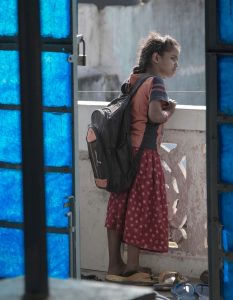Impacts of Income Shocks on Child and Adolescent Human Capital
Policy Issue
Low-income families throughout the developing world are highly vulnerable to shocks—drought, illness, temporary unemployment, or any other unexpected event. More specifically, environmental or economic shocks can limit a mother’s access to proper nutrition during pregnancy, which can impact the metabolism of a fetus, limiting cognitive development and leading to future health issues.
Context
In India, well over half the labor force occupies the agricultural sector, which is heavily dependent on monsoon rains. During drought, households that depend on farming often face reduced income, limiting their access to nutritional foods and health care. These impacts are especially detrimental to vulnerable populations, including pregnant women and infants.
While many studies have evaluated the effect of in-utero shocks on infant and child health, these studies are among the first to consider educational outcomes all the way to age 16 for children exposed to environmental shocks while in-utero.
Findings
In “Drought of Opportunities: Contemporaneous and Long-Term Impacts of Rainfall Shocks on Human Capital,” published in the Journal of Political Economy, we show that:
- Higher wages (as proxied by rainfall shocks) increase human capital investment in early life (in utero to age 2) but decrease human capital from age 5 to 16. We use various measures of human capital (math scores, reading scores, attendance, enrollment status, and timely progress).
- Children switch out of school into productive work when rainfall is higher (due to higher wages).
- The opportunity cost of schooling, even for fairly young children, is an important factor in determining overall human capital investment.
Follow-Up Work
In follow-up work, we examine the effect of a policy-induced increase in low-skill wages on human capital investment in rural India. We exploit the three-phase rollout of India’s National Rural Employment Guarantee Scheme (NREGS), one of the largest workfare programs in the world. This program raised local wages through the guarantee of 100 days of work at a fixed, above-market wage.
In Workfare and Human Capital Investment: Evidence from India, we show that:
- Each year of exposure to workfare decreases math scores by 2% of a standard deviation and enrollment by 2 percentage points among adolescents.
- While the impacts of NREGS on human capital are similar for boys and girls, we show that adolescent boys are primarily substituting into market work when they leave school while adolescent girls are primarily substituting into unpaid domestic work.
- We find mixed results for younger children, with the youngest children benefiting from the program most likely due to increased household income due to NREGS.
Policy Implications
The connection between environmental shocks and childhood development supports the need for drought relief and maternal health and nutrition programs in developing countries. The results also indicate that both time and income are important inputs into human capital, and that wage subsidy programs could potentially have counterintuitive effects as they reduce the time parents spend with their children and potentially encourage older kids to join the labor market, which could decrease human capital accumulation.
Future Work
Our new projects funded by the National Science Foundation will attempt to increase understanding of what returns to education look like in rural areas of India and delve deeper into child labor issues.





